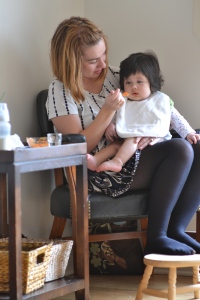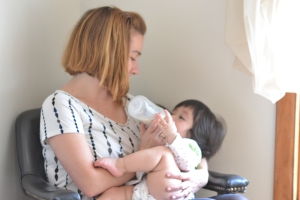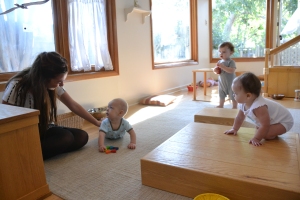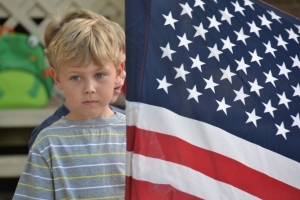Tag Archives: center base care
Ditching the High Chair: 5 Tips to Support Laptime Meals with Babies

At the center, coming together for mealtime provides an opportunity for connecting and leisurely enjoying our time together- refueling not only the body, but our relationships. Until a child is able to come to the table, you’ll find her secure in the arms of her Primary Caregiver – even the maturing baby sitting up on her own.

While individual one-on-one mealtimes may take longer than feedings by weaning tables or high chairs in getting the food down, the additional time spent provides not only physical replenishment, but also generates the social and emotional refueling necessary for a child to embark on individual free play and discovery. In the long run, this frees up the caregiver to be able to attend to other children during uninterrupted individual physical care routines with the same full presence and attention.
Lap feeding a more mobile infant, however, can sometimes be awkward and messy as the child attempts to participate more in her own care. Fortunately, the environment can be prepared in a way that enables both adult and baby to be most comfortable during this time together.
Let’s revisit this photo shared earlier…. what do you notice about the arrangement?

Lap feeding can be a new experience for the adult as well as for the infant. In order for the child to feel comfortable with the arrangement, the adult must be comfortable.
Before jumping in, consider these 5 Tips to Support Laptime Meels with Babies:
1. Find a comfortable adult chair with arms. Arm rests allow the adult to comfortably rest while supporting the lap fed baby. Rocking chairs are avoided in preference for a secure, stationary base- allowing for the infant to concentrate on the meal rather than the motion.
2. The small step stool provides the height needed for a more horizontal lap area. The adult’s comfort and sense of security is translated to the child. Without the stool, the area may be positioned more at an angle causing both adult and child to tense as they work against gravity.
3. The adult is careful to wrap her arm around the child in a gentle yet firm way. Be careful not to accidentally pin the child’s arm to your side. The baby has free movement of both her hands which she may use to explore, participate or soothe during your time together.
4. Before transitioning your baby to eat, prepare the environment ahead of time. A nearby tray contains all mealtime items including food in glass bowls, water in a clear infant size cup, warmed bottle, metal infant spoon, and washcloths for hand washing. The child can see the meal before her and can anticipate what is to come. Together with her caregiver she will communicate and help regulate her body needs.
5. The child is positioned in a way where she can connect with the meal process and with her Primary Caregiver. They are easily able to make eye contact and communicate verbally and nonverbally during their time together. Fully present and in tune with her baby, the adult is able to understand when the child cues that she is finished eating or in need of more.
If you are wanting to be together with your baby during meal times, you might want to ditch the highchair. The lap arrangement makes it easier for adult and child to connect during their time together during feedings. This connection fuels not only the chid’s body, but also fuels the relationship between child and adult. Both adult and child benefit from this leisurely meal together- refueled to continue their daily activities and responsibilities independently when they part.


This Ain’t No Daycare Baby
I was a daycare baby.
In the ’70s, still relatively few families involved both parents working and if they did, extended family often took care of the little ones. My parents, however, were members of a growing group of transplants without extended family who relied on two incomes to make finances work. At the time, daycare options were limited. High quality care was virtually non-existent.
It wasn’t until I was 8 years old that my mom finally had enough. A family therapist by profession, she couldn’t believe the challenges working families faced in finding a center with regard for CARING for young children. Although her own children had aged out of a pre-school need, my mom’s mental health background fairly screamed, “If you want to make a difference, start with children.”

In 1977 (77 being my parents’ lucky number) they dove in the deep end and to this day, both remain active in advocating for quality preschool education and support of early childhood professionals.
During the late 90s, in search of more meaningful work, I left the international commodity export trading industry to check out the daycare my family still owned in Charleston, SC. Over the past 15 years, I’ve come to recognize that while the center does provide childcare services, the word “daycare” doesn’t come close to describing the work going on here. I’m saddened by the idea, however, that even after all these decades many of our children still only have daycare options available to support working parents. The long term ramifications affect the very fabric of our society.

What do I mean by DAYCARE?
The best way for me to describe the difference between “daycare” and “early childhood experience” is to turn back to my first professional experiences as a food commodity trader where I sold frozen chicken- both as a commodity and the further processed value added versions- by the container.
When you evaluate childcare options as a commodity, the assumption is that all centers are equal. As such, the only concerns would be- what is your tuition? and- how much can I get for that price, or what are your hours of operation?
While tuition and hours of operation certainly play into a family’s ability to afford or work the care into their professional lives, our experience has been that extended hours and lower tuition correlates to the quality of care your child will receive while away from her home.

Extended hours often mean children shuffle from room to room as teachers stagger in for their eight hour day. Young children may find themselves in unfamiliar environments, with unfamiliar adults, amongst unfamiliar children of a broad age range. Lower tuition typically relates to lower wages and professional development and benefits for the early childhood caregiver. Both- extended hours and lower tuition- end up equating to teacher burnout and higher turnover.
An additional $1.00/day even for small schools with enrollment under 80 families can afford your preschool flexibility to lower ratios, add curriculum enhancements, or increase teacher benefits adding to the well-being of its community.

Research continues to pour forth validating the critical importance of the formative years and the return on investment society reaps in providing a stable infrastructure for a quality early childhood experience. Paradigms are shifting- our children are our greatest resource, the most valued of products we can produce. Yet still, for the most part, the burden of treating them as such rests on the professionals and parents willing and able to deliver.
Parents on the hunt for childcare balancing the fiscal, practical and ideal can arm themselves with additional evaluative measures outside price and hours in making their assessments. Consider-
1. Size matters: schools with larger enrollment have a more difficult time offering cohesion in quality. It is difficult getting to know families, children and faculty members as resources are pulled managing the administrative needs of large groups.
2. Administration guides school leadership: what are their qualifications and how long have they served the program? Often school administrators have little classroom experience which can inhibit their ability to resource teachers and parents.

3. Facility investment: do you see evidence of continued facility improvements? Facility upgrades and curriculum additions demonstrate a continued investment on the part of the school leadership.
4. Continued adult education: in addition to teacher credentials, what was the last training offered and why? Are parents encouraged to attend? Most states require a minimal number of continued adult education hours for early childhood professionals. Evidence that teachers are encouraged to extend training above these minimal requirements is a great indicator of how they are valued.
5. Teacher retention: many believe that it takes at least five years to become a good early childhood professional. Find out the tenure of your preschool’s teaching team. Turnover directly affects the quality of any program negatively.

On our part, you’ll find our tuition and fee schedule non-published. It is shared in person upon touring the facilities in an effort to help provide parents much of the information they will need in making their assessment on who will care and provide for their child when they are away.
A special thanks to David Vigliotti for capturing our moments together at Little Learners Lodge and Montessori of Mount Pleasant. Even before joining the teaching team in 2001, it is obvious through his photos that David has always shared an appreciation for the beauty presented in childhood and the dedication of parents and educators providing for young children.
RIEatized- definition of RIEatized free online…
| Adj. | 1. | RIEalized – restored to new life, vigor and understanding of Magda Gerber’s RIE Approach;
I first heard the term “RIEatized” from an infant specialist at Little Learners Lodge. Already a very competent and experienced infant caregiver self-educated in the RIE Approach, we sponsored her RIE training in Theory and Observation more as a formality. Yet when she returned from the training experience, she radiated with enthusiasm voicing a deeper understanding and appreciation of Magda Gerber’s work- “I’ve been RIEatized!” she exclaimed happily.
After attending the 23rd Annual RIE Infant/Toddler Conference for Parents and Professionals last weekend, I have a better understanding of what she means.
The presenters at each break-out session I attended conveyed a deep regard of Magda Gerber’s contributions to our understanding of infants as well as the inclusiveness of the RIE Approach. Parents, psychologists, early childhood practitioners from across the nation and overseas- be it traditional, Montessori or progressive- were connected by our appreciation of infants and toddlers. With almost 400 in attendance, I lit up with the feeling of belonging and understanding while surrounded by likeminded individuals. It was nice to be in a place where we could freely discuss the intricacies of supporting healthy human development from a societal framework.
Keynote speaker and renowned researcher, Allison Gopnik, PhD, author of The Scientist in the Crib and The Philosophical Baby and Magda’s son, Bence Gerber lent further fuel to the excitement.
Dr. Gopnik’s research recognizes, “Baby’s are a separate developmental stage in human development- as evidence by their brains…. a baby’s brain is better than an adult’s in its design to learn.” Yet this capacity, Gopnik further explained, comes at a high price. A baby requires the care of an adult- actually a TEAM of adults working cooperatively- for his survival. How the team cares for that child especially over the course of her first five or six years, will greatly influence the child’s ability to contribute to our social fabric when she reaches adulthood. Our brains are physically wired to assist us in our roles as we reach them- first as an infant and eventually as an elder.
We are best able to assume our adapting roles if we are adequately supported at infancy.
During her time with us, Dr. Gopnik focused her discussion on two crucial areas to assist the child the first six years of life- attachment and play. As a RIE Certified Center, we can attest to the particular attention the approach gives to both fostering secure attachment and to respecting the value of a child’s self-initiated and uninterrupted play. If you have a few moments, you’ll find components of Gopnik’s keynote via TED:
As important as it is in “getting it right” with infants, the infrastructure we currently have in place in providing parents and early childhood professionals with the resources they may need to care for babies seems lacking- adversely affecting our security early on. For example, infant teachers remain under-valued as a profession with a high degree of burn-out and turnover. And many policy makers lack the experience of being childcare providers- while they value the importance of infant care, really don’t know how to give it.
As a result, early childhood professionals- (don’t forget unlike many elementary teachers, these guys are working year ’round)- lack the time, energy and resources to advocate on a political platform that which we know to be best practices in implementation. In addition, those not in the field are becoming more exposed to research validating our work and- with the best of intentions- feel driven to institute practices to “teach” the child, negatively impacting his innate drive to learn.
I felt the need for a little re-RIEatization. Thanks to all the RIE (volunteer) Board members and Dr. Allison Gopnik. Let’s get this party started: Advocating for the Importance of PLAY
|
To Comply or to Conform… that is the Question?
“How do your children transition to first grade?”
I wasn’t surprised by the question which typically comes up during a tour. I was surprised, though, that this Dad was worried about first grade readiness. His baby wasn’t even born yet.
Immediately, my mind sifted through to the barrage of information, research, affirmation, test results, lesson plans, teacher qualifications, school accreditation checks and balances which I typically share with Primary aged families. I looked into the father’s eyes then glanced over to his wife; what could I tell these soon-to-be parents that would help guide them in their decision making process on how to provide best for their infant in a way that would prepare him or her for the rigors of later academics and life itself?
 My thoughts turned back to our current Kindergarten students; what attributes do these individuals convey that best prepares them for elementary success? Each armed with unique gifts, resourcing abilities, temperaments, family cultures, weaknesses requiring scaffolding, testing abilities, self-regulatory capacity. Looking outside my office door, the eldest student answered the father for me.
My thoughts turned back to our current Kindergarten students; what attributes do these individuals convey that best prepares them for elementary success? Each armed with unique gifts, resourcing abilities, temperaments, family cultures, weaknesses requiring scaffolding, testing abilities, self-regulatory capacity. Looking outside my office door, the eldest student answered the father for me.
Together the Expectant Parents and I watched as the six-year old began negotiating with two of his peers deciding who would get to play chess with him and who would watch- they both wanted to play. Michael tried several tactics to please both of his buddies, but neither seemed happy with the solution.
Michael did not give up, finally giving up the chess game for a work which could involve all three of them. Later that morning, he was able to return to his first choice of chess once his friends’ needs had been met. Many things struck me about the interchange we witnessed- at the core, what struck me most was Michael’s ability to know himself and his desires, appreciate and respect the desires of his friends, stay in tune with the group throughout the discussion and then comply with a group request of togetherness without conforming by giving up his own desire.
He was able to say, “OK. Right now we’ll do what you want. It seems really important to you. Later I will do as I desire.” – something that some adults have difficulty managing.
So where is this foundation laid?
We think early on- at infancy- from the moment of birth and first through our everyday care-giving routines.
A RIE baby attains a strong sense of value and respect beginning with how he is cared for during eating, sleeping and diapering routines. At play, his concentration and motivation are carefully observed and the environment is prepared to follow his interest and regard, which he shares with his primary teacher by touching base and refueling. The discovery is open-ended and while the routines may be predictable enabling security, the timing is set by the child.
On the other hand, parents are advised that in order to be wise, they must put children on adult centered schedules, feed by the clock rather than body cues, wear their babies on their bodies throughout the day or place them in positions the child can not get herself in and out of. With the best of intentions, well-meaning parents and educators ask an individual child to conform to their expectations; in her efforts, the baby adapts and develops a need even for that which is preset for her. It can be difficult not to ask a child, though, to conform to an adult schedule or activity which allows for us to ensure that everything that needs to be done for baby and adult is taken care of. However, it can be difficult for the child later to know what she wants and resource herself in getting needs met, to regulate his own body, to feel secure without the presence of outside support, to trust herself.
Learning to comply- a necessary skill in becoming a contributing member to society- or learning to conform- requiring the input of another to move forward starts with our regard of babies. An infant regarded with love and respect by his primary caregivers develops the skill to read and understand his community and wants to contribute to its success. Eventually he complies- sets his impulses-or will aside (self-regulation) in order to help the group, to which he feels he belongs to, be successful.

A RIE baby isn’t asked to conform- he is invited to cooperate.
A RIE baby complies- she wants her family to succeed.
Being true to yourself while being sensitive to the needs and desires of others is not only a vital life skill, it also assists the child in transitioning to new environments. To collaborate, cooperate, comply takes time and a degree of sophistication.
















